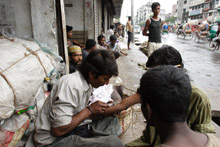Naimul Haq
DHAKA, Nov 2 2010 (IPS) – It is one of the poorest countries in the world, has a low literacy rate, and is next door to at least two countries that have a considerable portion of their respective populations with HIV and AIDS. Yet even having a large migrant population has not made Bangladesh a hot spot for HIV and AIDS.

A group of drug users in a Dhaka suburb. Credit: Shafiqul Alam Kiron, Map/IPS
Indeed, there is a host of factors that render the country highly vulnerable to a surge in HIV (cases), says Muhammad Abdur Rahman, head of the National HIV/AIDS and STD (sexually transmitted diseases) Programme (NASP).
But, he continues, I think the government s decision from the beginning to act as a catalyst and recognise NGOs (non-government organisations) that have real capacities to implement HIV and AIDS programmes were the key to (its) success.
Official data show that since the country had its first HIV case on record in 1989, it now has some 1,745. Including unreported cases, the real figure is estimated to be a relatively low 7,500. Overall, HIV prevalence rate in Bangladesh, a country of more than 164 million people, is less than one percent.
By comparison, neighbouring India has 2.31 million people living with the virus, while Burma, which has a part bordering Bangladesh, has 240,000.
Experts agree that unlike its neighbours that did not pay close attention to HIV and AIDS until it had become a major burden, Bangladesh recognised it early and acted immediately to limit its spread.
Related IPS Articles
Indeed, the public and private sectors have been coordinating for decades to establish strong prevention networks.
There are many partners that supplement the state s responsibilities and they acted early, particularly working with the groups who engage in risky behaviour, says Habiba Akter, executive director of the Ashar Alo Society, a leading group working on HIV and AIDS issues. (This) is why Bangladesh still enjoys low HIV prevalence today.
Rahman cites the importance of having the South Asian country s print and electronic media as major partners in building awareness about the disease. The government has also made it a point to raise awareness and knowledge about HIV and AIDS among the youth, making it mandatory for secondary schools to include informal education about it.
Comments journalist Mustafiz Shafi, also an HIV and AIDS activist: There is a general awareness about (the illness) among the population, especially among the (youth) who are most vulnerable to HIV transmission.
In addition, populations that are considered having behaviour most at risk such as injecting drug users and sex workers and their clients are closely monitored. And, says Rahman, We have a very good system of reporting any sickness, especially in garments factories and other similar factories where young people work.
There are designated clinics where sick people can seek free treatment or testing if reported ill, he adds. All such sub-clinics are advised to send information on any signs of risky behaviour and advise (people showing these signs) to volunteer for HIV testing.
The government has a very strong monitoring and evaluation cell on HIV and AIDS across the country, affirms Rahman. We have been relying on such strategies to fill any gap so that interventions are not missed.
An important component to the country s HIV and AIDS monitoring system is the network of some 150 NGOs that coordinate and report regularly on newly detected cases to the central data storing centre here in the capital.
This system also helps people who are diagnosed with the disease find the nearest organisation that would be able to give them advice and whatever else they may need.
It was like being in mother s lap, says a street vendor here who was introduced to Ashar Alo shortly after he found out he has HIV. The first few sessions of counselling, peer education, and advocacy on positive living were very helpful as I was almost lost.
The Athar Alo Society was among the first NGOs in Bangladesh to establish strong HIV and AIDS advocacy programmes across the country. Among others, it works for rights-based support for people living with HIV and AIDS, including social security.
Still, NGOs and the government alike know that they cannot be complacent despite their continued success against the virus.
The street vendor working with Athar Alo is one reminder that they need to remain vigilant. Poor and illiterate, the vendor was also an injecting drug user. In the last national serological and behavioural surveillance done in 2007, injecting drug users in Dhaka were found to have an HIV prevalence rate of seven percent, up from 1.4 percent in 2000.
And while people from all walks of life in Bangladesh have heard of HIV and AIDS, misconceptions persist about it.
Thirty-five-year-old vegetable shopkeeper Mohammad Saidullah, says, I think a person (with) the virus should stay indoors as she or he may transmit it coming in contact with others.
It is better to stay away from people carrying the virus, a 24-year-old homemaker also says. If you touch their sweat or drink from the same glass, you may get the virus.
Tasnim Azim of the International Health Research Institute points out as well that people living with HIV and AIDS in Bangladesh are often at risk of being denied the medical care they need.
(They) desperately need accessible and reliable clinical care, she says. At present, clinicians and hospitals are not open to providing services especially if they require surgical care even if it is minor surgery.